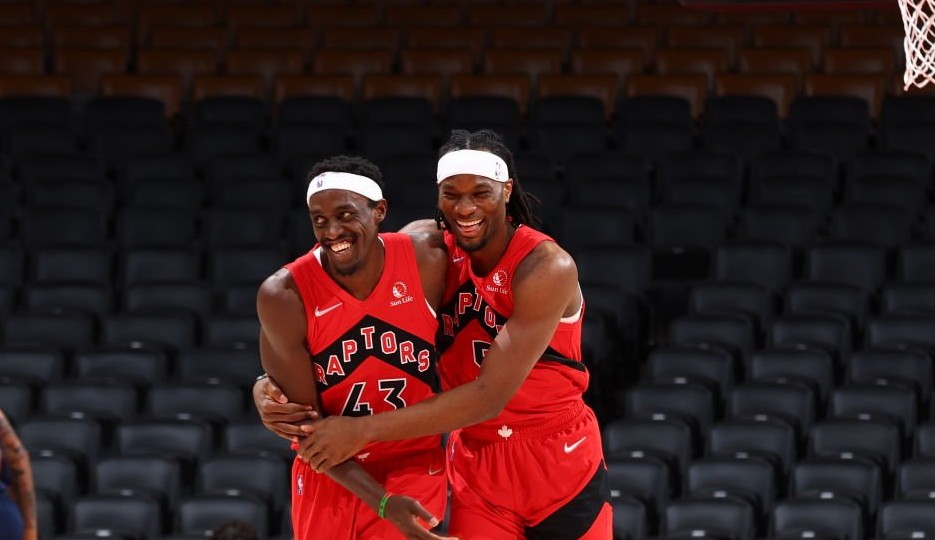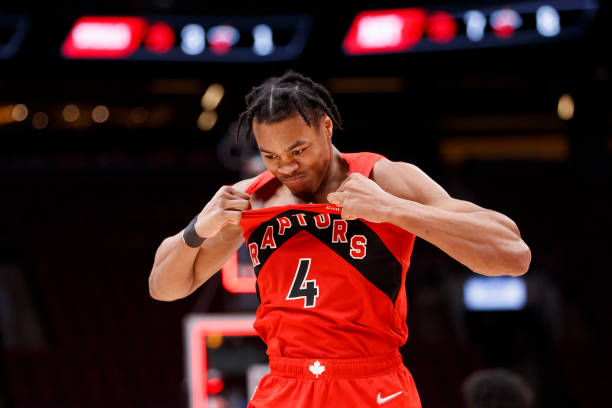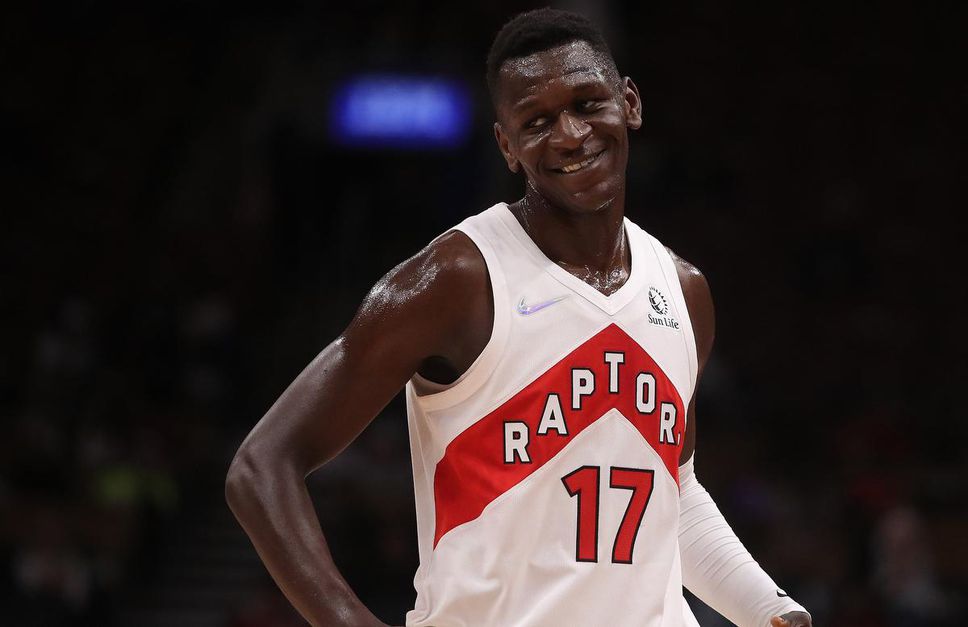Napoleon Bonaparte ruled twice. He of course rose through the ranks of the French military in the newfound French revolutionary Republic, fighting in Italy and Egypt en route to becoming Emperor. And as Emperor he conquered much of Europe. But after his defeat, he found himself in exile on the Mediterranean island of Elba. Story over? Not quite. On Elba he oversaw a huge modernization effort of the legal system, infrastructure, and agricultural system of the island. But within less than a year, he escaped the island and landed in France. The regiment sent to arrest him joined him, and he quickly became Emperor of France once more.
The Toronto Raptors are in the midst of their second ascension to power. They rose, of course, to seize a championship from the tyrannical Golden State Warriors behind their uniquely adaptable team defense. And then, alas, the fall. Call Tampa Bay Elba, but with not as welcoming a climate — the Raptors were booed at home — as a Mediterranean island. Now Toronto is slowly creeping back to relevance, sailing home, perhaps gathering its former might. And once again, its doing so on the back of a fearsome defense only preceded by its own former iterations.
The Raptors opened the season playing statistically solid defense. From the beginning, it was clear what the vision was on the defensive end:
“A lot of high deflections, there were two or three or four on one possession, that’s what we’re trying to do, we’re trying to use some of that length and turn it into offense,” said Nick Nurse after a win over the Houston Rockets. “I still think we probably didn’t turn enough of it into offense. Thirty turnovers, 32 points. Thirty-two points is a nice number, but that number per turnover should be a bit higher.”
(As a point of comparison, 2020-21’s leader in transition points scored 24.9 per game.)
Within the month of October, they had the seventh-best defense in the league behind 11.1 steals per game and 20.0 points per game as a result. But there was still something missing on the defensive end. Rotations weren’t perfect. If Toronto didn’t force a turnovers, opponents shot fairly well — right around the middle of the pack, and a far cry below Toronto’s ostensible seventh-best ranking. There were worrisome indicators.
“It took us some time this year,” said Nick Nurse recently of his team’s early defense. “The start of this year, we weren’t able to go out and execute much of anything. We were playing hard, and we were deflecting the ball, and we were creating turnovers and stuff, but it just wasn’t very cohesive and not in line with the schemes we were trying to run.”
The defense was there, but it wasn’t all the way there. And then things fell off a cliff. From Nov. 5 to 18, the Raptors lost six of seven — again, largely because the defense became a catastrophe. Toronto stopped forcing turnovers, and without turnovers, they simply couldn’t get stops. Their defensive rebounding became an issue. Opponents feasted from the corners and at the rim — the two most efficient non-free-throw areas from which to shoot a basketball. I wrote this in the middle of November:
“It’s hard to know whether Toronto’s defense over the first 13 games was the real thing or not. They forced a whack of turnovers, cleaned their own glass, and forced opponents to play in the half-court more than anyone else. That on its own was enough to play some inspired defense — seemingly. But there were subtle issues, fault lines lurking beneath the surface the whole way.”
Those fault lines caused earthquakes for a time, but Toronto has fought through them and emerged stronger on the other side. They’re starting to close. Since New Year’s Day, the Raptors have again rebounded to having the seventh-best defense in the league. This time, though, it’s driven by solid fundamentals. The Raptors have always had the elite individual defenders. But for the first time since 2019-20 (“you can throw last year out, we couldn’t execute anything last year,” said Nurse), those talents are starting to blend into something better, something more cohesive. Here’s how.
For most of the season, the Raptors really only have had one elite rim protector, and it’s been Precious Achiuwa. He ranks 12th in the league in opposing field goal percentage within six feet dropping off due to his presence, and his minutes have been trending upwards over the course of March especially (coinciding with Toronto’s rise up the defensive standings). He beats players to their spots at the rim, is so strong he can’t be moved, so long you can’t shoot over him, and he’s mastered verticality. But during the same month, Pascal Siakam and Chris Boucher have also joined him on the list of the league’ most effective rim protectors. Toronto is returning to its collective-rim-protection roots, with not a single player camped in the paint and taking on all comers, but instead relying on ahead-of-the-ball rotations and trusting that when even Achiuwa leaves the paint, someone else will be there when the time comes.
That variability, the trusting of one responsibility to multiple players over the span of even a few seconds, was a hallmark of Toronto’s championship defense. It’s slowly returning. Players are making the correct choices in fractions of an instant, and not just the elite players, the trusted champions like Fred VanVleet or Siakam. Now it’s the role players like Boucher whose instincts are reflecting scheme — he now has the best defensive on/offs on the entire team after never recording a negative defensive on/off previously in his career.
The Raptors have gone from multiple players making glaring errors on the same play (let’s count — Boucher doubles the post from a horrible angle and then doesn’t recover to the play after the pass, Achiuwa plays his hand way too early and doesn’t bother with dissuading the pass to the corner at all, VanVleet doesn’t sink low to cover the corner)
to sharp rotations becoming the norm (again, let’s count –great recovery by Siakam, nice handoff of defensive responsibilities from Achiuwa, gorgeous dig from Scottie Barnes, and fantastic job from Boucher cycling through a few different options at the end of the play to close to the right spot to contest).
Boucher is a good representation of Toronto’s defense: he used to chase highlights and now favours solidity, never sacrificing rebounding position, challenging more shots but recording fewer blocks, and far more frequently rotating correctly. His length has never been such a weapon. He may be representative, but he’s far from the only one. Toronto has an answer to every possible offensive archetype. Need a defender for a back-to-the-basket balletic brute like Nikola Jokic or Nikola Vucevic? Khem Birch has found incredible success recently, combining his positional solidity, length, and strength to stymie both players in the post.
Need a switchable big who can defend face-up bigs or guards in isolation? Achiuwa has emerged as Toronto’s premier defensive stopper with OG Anunoby injured recently. Not a whole lot of players out there who can hang with Joel Embiid and James Harden. Per NBA matchup data (lots of problems, very shoddy, but this is still fun), he held the two to 4-of-18 shooting on Mar. 20. Even with shoddy data, the video is all the proof we need.
Need a wing who can switch onto guards or bigs, clean the glass, rotate like a demon, and hang on an island? Well, the team’s built out of those — Siakam, Anunoby, Barnes, even Thad Young. The guards in VanVleet and Gary Trent jr. force turnovers. VanVleet, especially, is as malleable as Achiuwa, capable of limiting the point of attack, rotating to plug gaps, dig to force turnovers, double the post, switch and hold his own, and close out possessions by contesting huge swaths of territory. The number of weak points are falling out of the rotation; players like Dalano Banton and Svi Mykhailiuk aren’t getting minutes, and others like Boucher and Achiuwa have improved dramatically. Barnes and Trent still have long ways to go to equal their teammates, but they can at least be part of good defenses, if they’re not exactly the strong points.
But the purpose of Toronto’s defense is to take everything away. Damn the good, say the Raptors, let’s be perfect. At times they have been.

(Worth mentioning that pick and rolls are the staple diet of NBA offenses, so forcing lower usage directly out of them is actually good (check!) while isolations are generally less efficient, so forcing more usage out of them is good (also check!))
Over the month of March, Toronto has been a top-four team at defending both the rim and the corner, long considered an either/or proposition for the team. That may actually be burying the lede: corner threes have been Toronto’s Achilles’ heel for years. If the Raptors are starting to turn the corner (ha) there, that shifts the entire trajectory of the defense. That means the scheme has no weakness. And Toronto is also the single best team in the league at forcing opposing offenses out of transition and into the half-court, meaning the Raptors not only have sharp half-court teeth, but they also get to spend a league-leading amount of time ripping into opponents with said chompers.
Since the start of March, Toronto has slipped to 15th in steals — average! But not only has the defense not fallen off a cliff like it did in November, but instead it’s improved. That’s what happens when you eliminate the fault lines; natural disasters shake you up a whole lot less!
“The coaching staff and the players have stayed with it and kept drilling and working and polishing and all those kinds of things, and it’s kind of a time and chemistry thing,” said Nurse recently of how the Raptors have improved defensively.
Part of that drilling and working and polishing has meant that Toronto’s traded the spectacular for the solid. Of course Nurse would be happy if the Raptors led the league in opposing turnovers once again, but he’s probably far happier that they can still get stops without turnovers. Further to the point of solidity is that the Raptors don’t have a single or even a few players driving the defensive improvement. No player’s on/off defensive rating per 100 possessions is better than -4.3 points, which is good at 81st percentile, but fairly low for a team leader. (To repeat, it’s Chris Boucher.) Seven of Toronto’s current nine rotation players — excluding Birch and Trent — have negative on/off defensive differentials, meaning the large majority of the rotation helps the defense more by being on the court. (Birch, simply by being Achiuwa’s replacement and playing few minutes alongside him, is hurt in this category because Achiuwa has been so impactful defensively.) There are no good defensive and bad defensive units, as the Raptors used to play under Dwane Casey. Now every lineup menaces that side of the floor.
Toronto’s improvement is a collective effort, a group shift towards becoming more than the sum of its parts. And the parts are quite valuable, defensively. Anunoby, VanVleet, Siakam, Achiuwa: all have pretty good shots at landing at least one All-Defensive Team slots at some point in their careers. But for long periods this season and last, their defensive talents have been wasted. A huge number of possessions this year have seen Siakam, for example, run across the court multiple times, switching from guards to forwards to guards to bigs, only for a breakdown elsewhere to yield an open catch-and-shoot jumper. (Siakam, by the way, is sixth in the league in contested 3s and 10th in distance traveled on defense per game. Want a crazier stat? He’s only fourth on the Raptors in distance traveled on defense, with VanVleet, Anunoby, and Barnes all ranking ahead of him.)
When it works it works not because of individual heroics. The Raptors have a meaty defensive playbook, and they can whip out some bizarre stuff for no reason other than the fun of it. But the real bones of the thing show in the everyday structural integrity. This defensive possession features a whole lot of defenders beating cuts and drives to their intended destinations, clean switches, and individuals surviving in isolation. (Watch the clip through focusing on each player for maximal fun, but let’s just focus on Siakam here: he dashes into the paint no fewer than four times not even to put out fires but just to douse the area with water to smother smoke before flames even appear.) No single player wins this possession, even though the Raptors’ lineup employed a variety of defenders capable of such things. Instead, individual heroics are saved as bailouts rather than the foundation.
It would be fair to wonder whether the Raptors would be a better defensive team if they just played simple, conservative defense. If they rarely helped, let their best defenders swallow space and static attacks, and asked their platoon of centers to rarely leave the paint so as to contest everything. Honestly, they might have a better season-long mark, which is only 12th at the moment. But they wouldn’t be as prepared for the playoffs. Nurse has spent the last several years reinventing NBA defense, and he’s done it not for regular-season rankings but to turn the league on its head when the games matter. That happened in 2018-19. And the Raptors are starting to live up to their reputations once more, starting to gather up the ammunition they’ve lacked, load their weapons, and lock in on whomever is unlucky enough to draw them in the first round.
Napoleon’s second rule did not last very long. He raised the Grande Armée once again and marched off to face another coalition for the soul of Europe. But he lost in a very Raptors-y way. The Duke of Wellington and the English held him up, wave after wave of French assault, while Wellington’s Prussian allies descended. Napoleon’s offense failed him at the critical moment, and his reward was another island prison, this time Saint Helena. The Raptors are finally returning to their defensive roots, which is a worthy and commendable achievement. But unless they become a true terror on both sides of the ball, they may follow Napoleon’s lead in finding their exile from the promised land continue apace.



